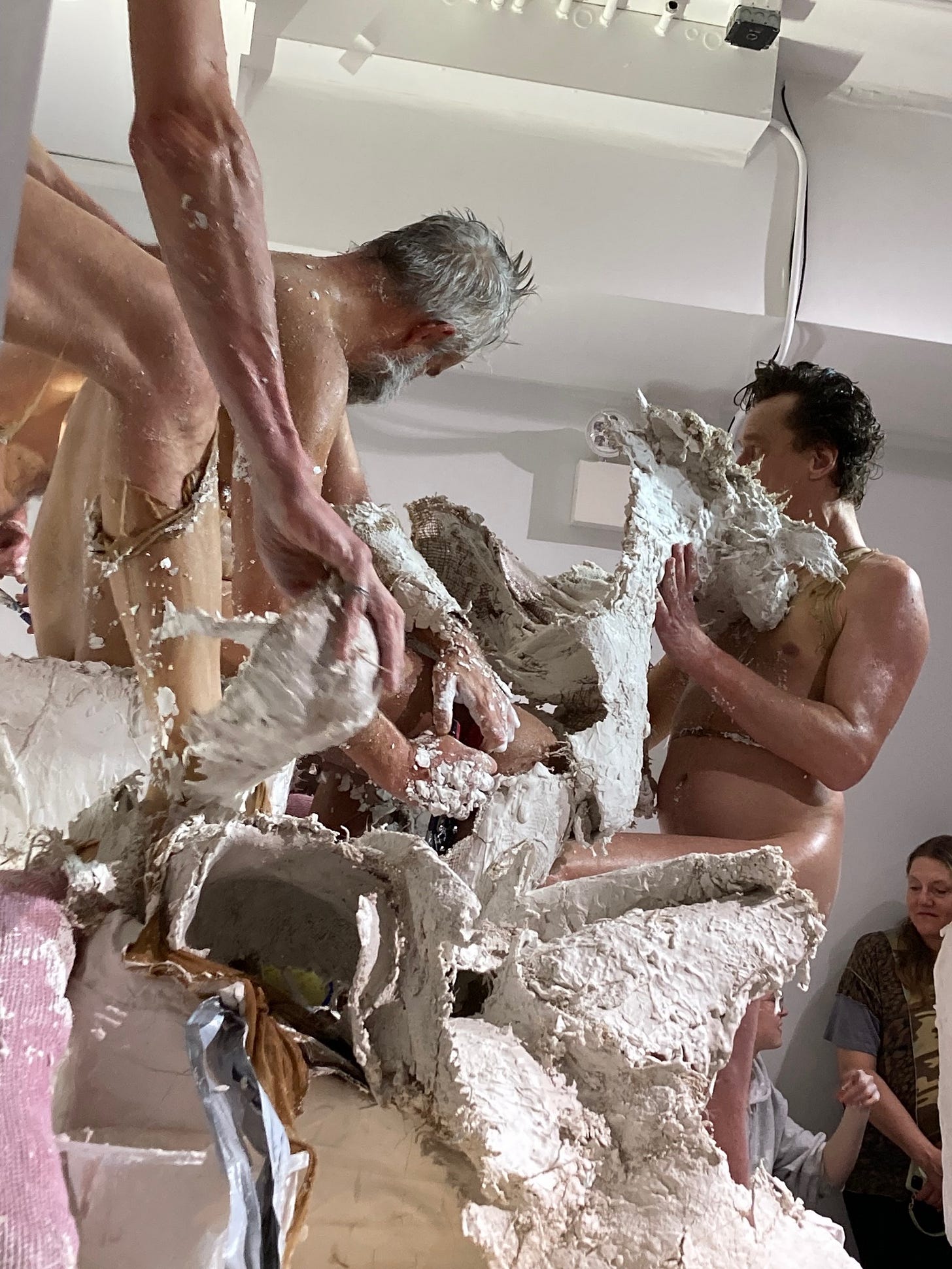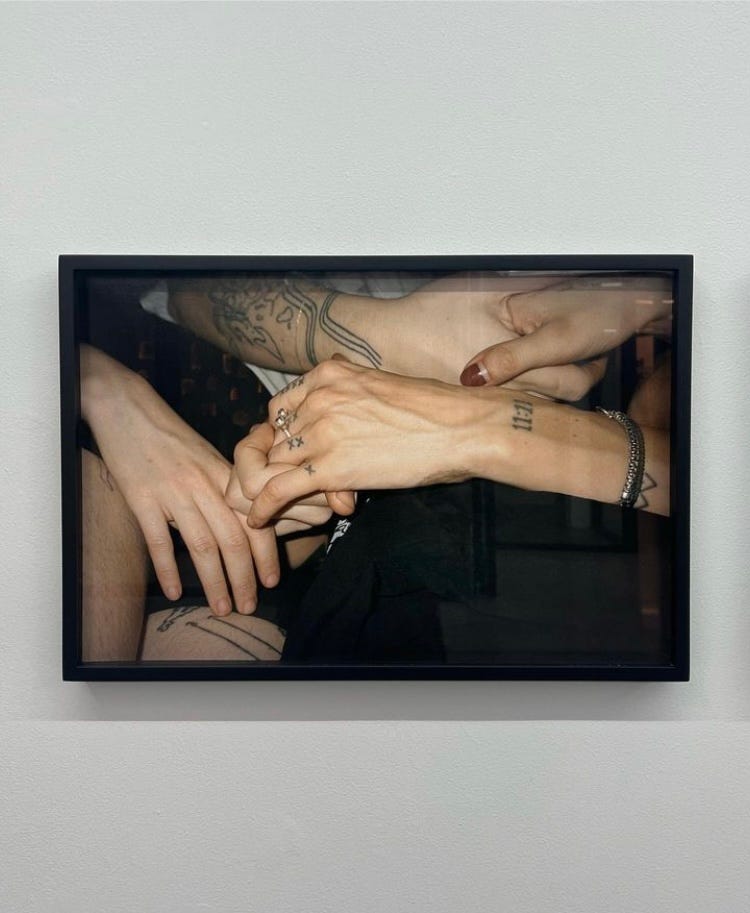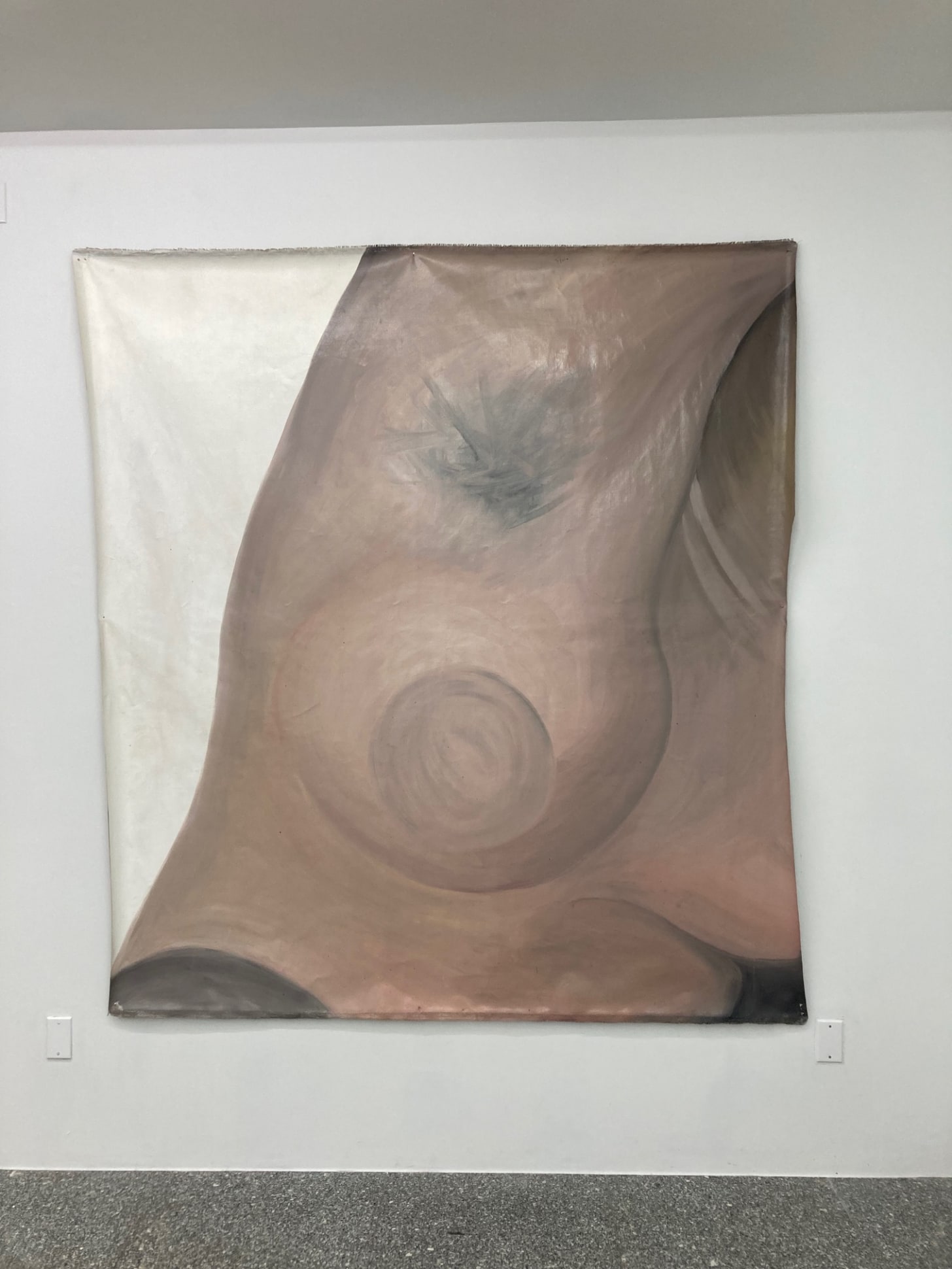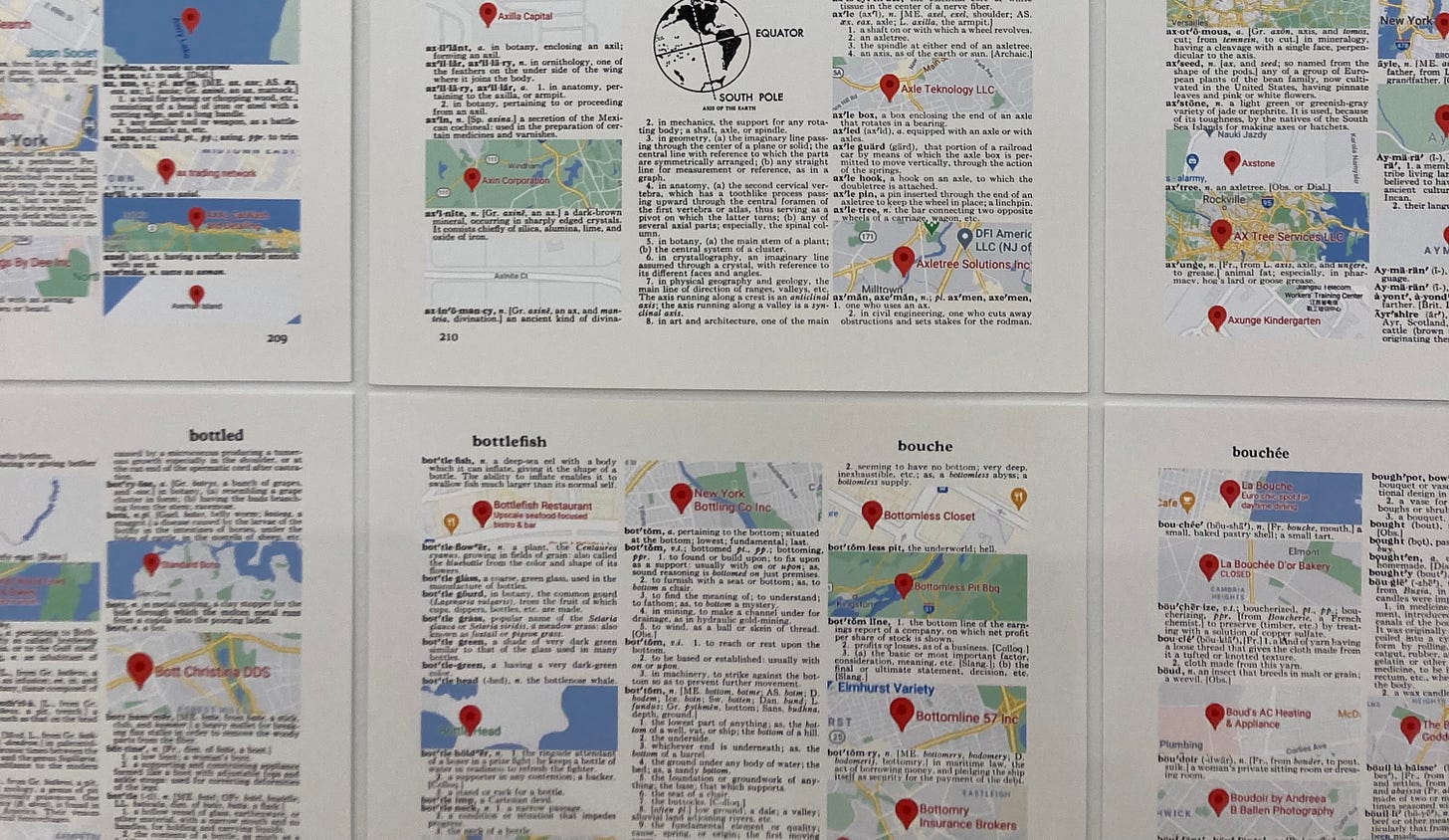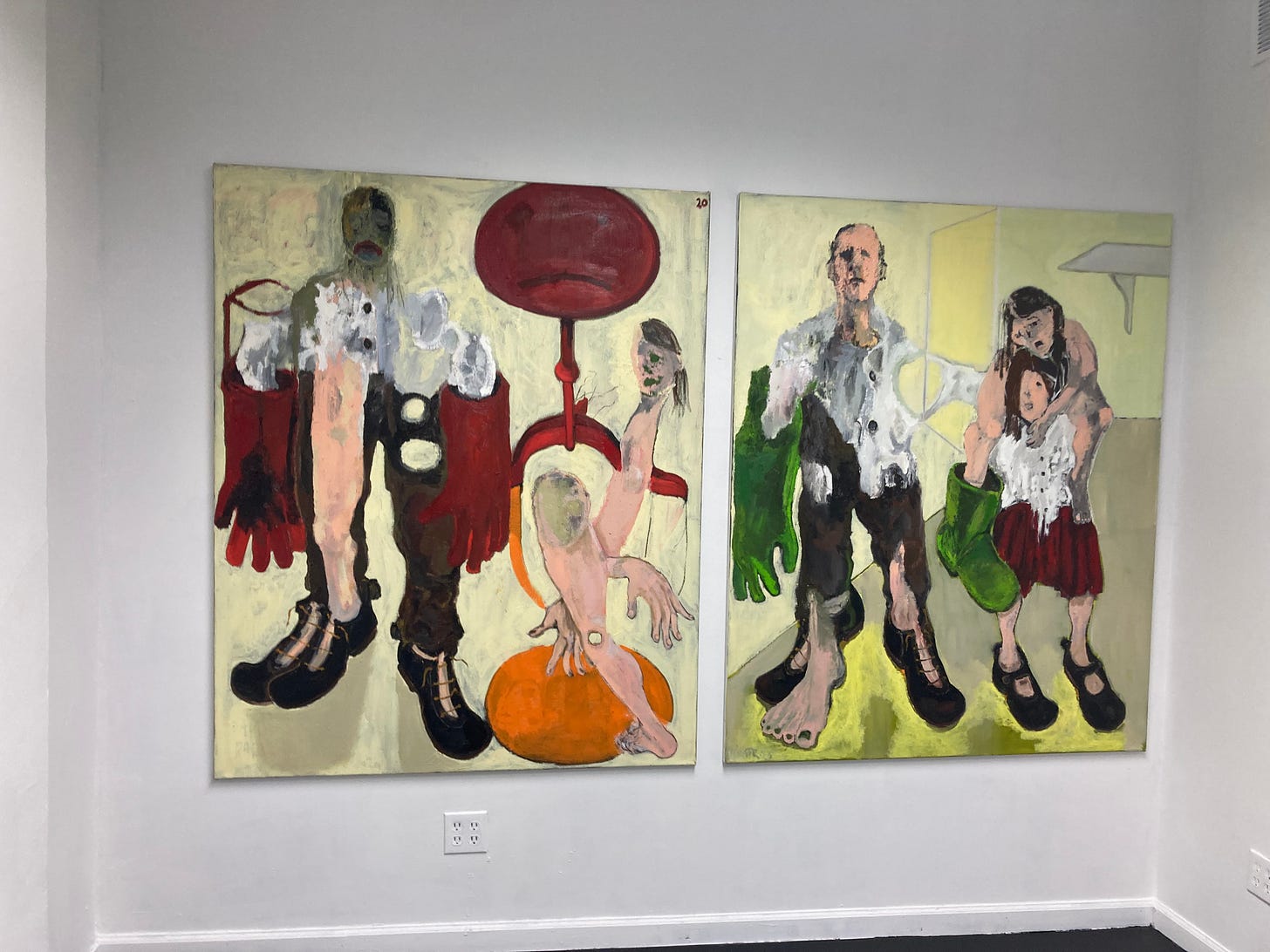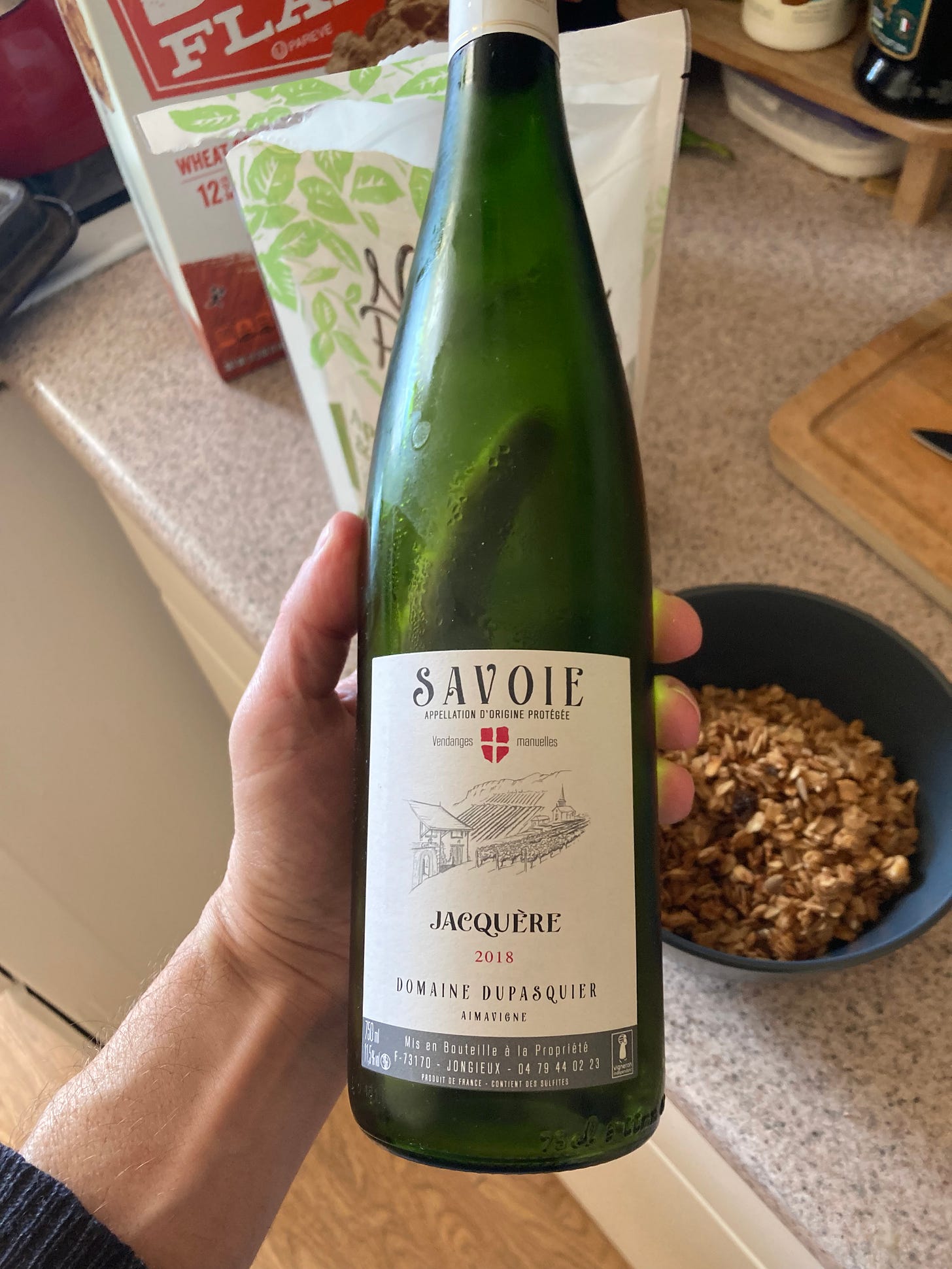The Valley of Humiliation
Gelatin, OCD Chinatown, mountain wine, and the passions of Flannery Silva
Gelatin is back, and with them O’Flaherty’s. The post-Aktionist vulgarian performance sculptors are as if invented for the gallery’s anarchic ethos and for its large, theatrical new space, previously a comedy academy and before that a one-screen movie house owned by a pizza shop. Gelatin’s work tends to make about as much sense as that, gleefully. So far, one gig has involved their imprisonment within a giant slice of pepperoni pizza, heads popping through like an unsavory topping you definitely didn’t order; another, the group’s making portraits of audience members with paintbrushes stuck in their assholes—crude in more ways than one.
Caricatures, you say? Assholes? The Ulman show at Jenny’s truly is unescapable.
Gelatin’s opening performance, which doubled as O’Flaherty’s rechristening, entailed the group being daubed onstage with plaster in a sculptural formation to form a cast for a deranged Burghers of Calais. Meanwhile, for the entire two hours, Ruby from O’Flaherty’s sat on a platform elevated mid-theater and played spare solo electric guitar, a gig that seemed almost as draining as being ossified alive. At the very end, the group busted out of their shell, dirty, sweating, and clad only in nylon stockings. To my shock, I found it moving.
You have three more chances to catch the group during the show’s crammed-full three week run, in gigs including the infamous Berlin-based Young Boy Dancing Group. They famously share Gelatin’s affinity for assholes, their implement of choice candles, who occasionally scorch their audience, at least according to accounts I’ve heard from the Continent. In their defense, Young Boy Dancing Group successfully held an exhibition at OCD Chinatown a few years ago without burning down anything.
I went to OCD last weekend to see the current exhibition, “It’s Personal,” a show of three friends who are all trans women. The show is about intimacy and the valances it takes on in a situation where the whole of society is up in your goddamned business in the most intimate and often hazardous ways, when everyone seems to think they’re entitled to an opinion about you and your body.
My favorite works in the show are Sam Penn’s photos, which cling close to their subjects while seeming to hover at an ever-so-slight distance; they dramatize the fact that a photograph is only ever a surface and, to me, stage the show’s core tension, the differences between being part of something, being invited into something, and gawking from the outside. A large, unframed Ser Serpas painting of an armpit and breast presents a literal exposure, but the image’s abstraction turns it into a blankness, a refusal—to be a little trendy, an opacity.
Hannah Baer wrote a really good text to accompany the show, on precisely the subject of who is allowed or prescribed to pry into the lives of women, and implicitly trans women: “don’t worry she’s not looking back you can stare, you should stare, look at her slash they, look as closely as you want she can’t hear you or smell you.” A copy of it is tacked onto the wall, headed by the instruction TO BE READ ALOUD. I like to think at least one person’s taken it literally, like a Fluxus score.
Music (and Art)
This song drives me absolutely insane. I listen to it over and over.
F.G.S. is the alias of Flannery Silva, an artist and musician I discovered via the writing of Spigot’s #1 fan, Paige K. B. Silva is a former member of the band Odwalla88 (aka Odwalla1221)—and in fact, her and her bandmate Chloé Maratta have a two-person show currently running in Los Angeles.
Silva’s work eludes description; she presents the raw matter of girlhood and girlyness but carves it into candyish forms with a painfully seasoned knife, the whole of its density pressed into an uncannily clean surface. Silva’s tone is practically unique. Every work feels like a doppleganger of itself, a dark tulpa, like the metal ballet shoes on view now at Soldes. Like the artists in “It’s Personal,” she too seems to be laying claim to a kind of opacity, one that disguises itself as pure exposure.
Like Silva’s art, “Passions” is skewed and cryptic shadow pop, in the song’s case of the Laurel Canyon variety. It goes down as easy as that mountain Jacquère, and yet there’s something disturbing about it—those ballet shoes look a lot like medical braces or BDSM props. There’s a splinter of metal lodged in the song’s lyrical double cherry, which leads its inexplicably ebullient protagonist through “the valley of humiliation.” It’s a bouncy karaoke track about degradation.
The video doubles down on the mood of blankly participatory eroticism. A topless Silva in a vaguely Mennonite head kerchief and white stilettos strikes cheesecake poses in a photoshoot on a dirt farm. Animated blue butterflies flap about to cover her nipples like they got lost on their way from the Sierra Nevadas to the Disney lot in Burbank. The lyrics are provided so that you, dear reader, can sing along.
Two Shows Closing This Weekend
Two shows in NYC I really liked close on February 25. On the face of it they’re both arch-Conceptualism. Yet both employ idiosyncratic systems with aims so quixotic or impenetrable that their work exposes a personal, idiosyncratic element that ends up complicating a lot of conceptual art.
(1) Luis Camnitzer at Alexander Gray. The 85-year-old artist has wallpapered the gallery with section A–Cosmopolite of a mad project to annotate the entirety of Webster’s unabridged dictionary using Google Maps. Here and there on the page, Camnizter intersperses cartographic slivers related to the words being defined. Boll weevil, for example, is accompanied by a map with a pinned location designated as US Boll Weevil Eradication, outside Chatanooga, Tennessee. Catso, a word for “rogue” or “cheat,” appears with an unidentifiably tight mapping of an acronymed entity called CATSO, just off an unknown body of water. There’s something logical yet crazy and also poetic about cross-referencing an apparatus that claims to contain a whole language with one that that claims to contain the whole world. But it’s also fun, just like it’s fun to flip through a dictionary or an atlas.
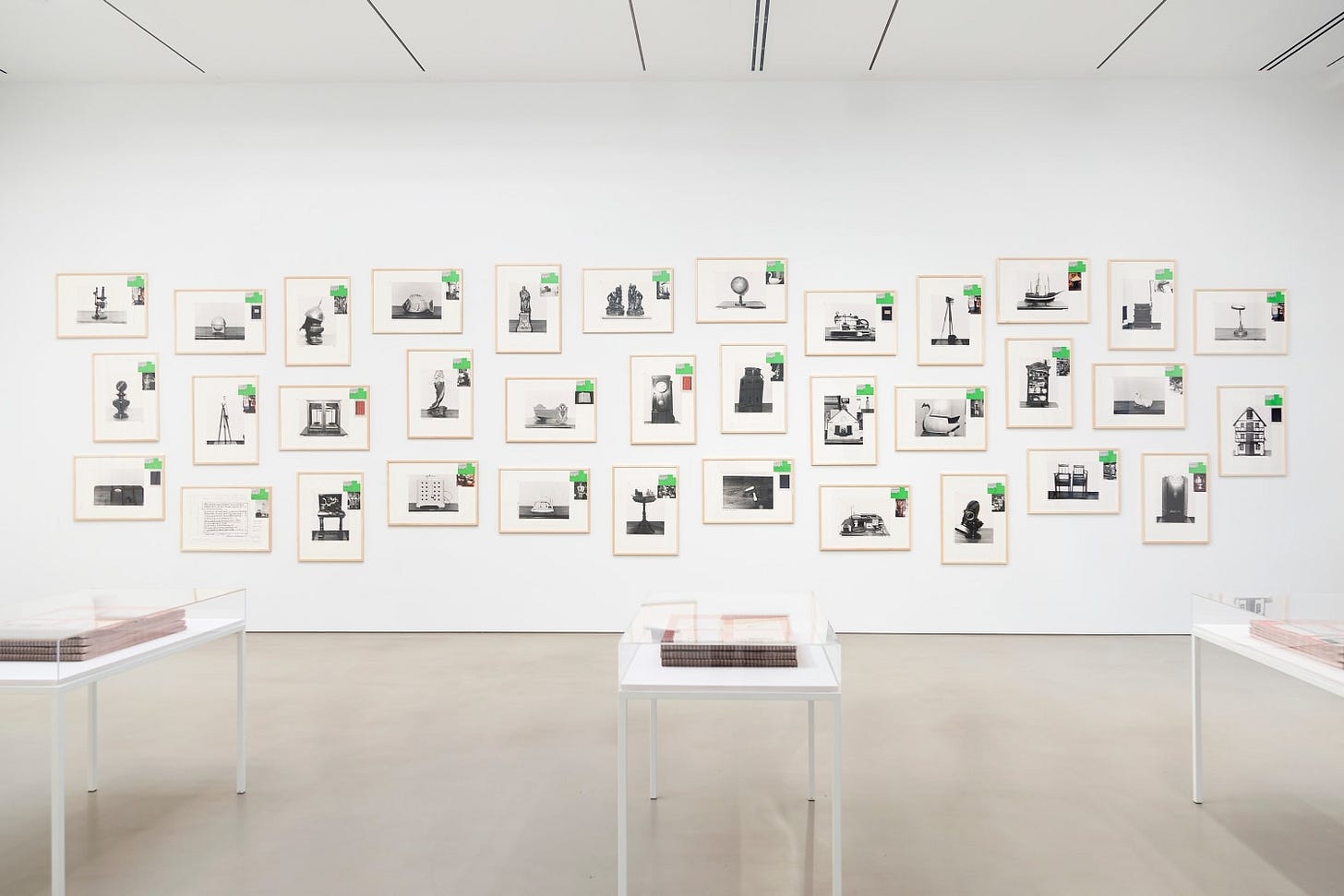
(2) Hanne Darboven at Petzel. To be honest, I’m ill educated on Darboven’s work; I have no idea what she was really up to. But I’m not sure anyone totally does, which brings her work into an unexpected tone, that of ecstasy or divination.
As with Camnitzer’s dictionary pages, poring over Darboven’s meticulous charts and Becher-esque photos of domestic items is utterly engrossing. What are her gridded accounting systems taking note of? What is the logic system behind her coding of the photographs, which involves numeration, an annotated card, and other photos? I assume you, Spigot reader, are capable of the sustained thinking required to digest such work, unlike those who confuse their (eye)balls with their brain and breeze through shows in a cocksure 60 seconds.
One such critic—whom I read rarely, only to make sure I have the opposite opinion—wrote of the Darboven exhibition, “I don’t care to understand her structural methods any more than the way they make things look.” My friend, have you heard of the Dunning-Kruger effect? Or, to speak in a vernacular that suits your attention span: DO YOU EVEN LIFT?
Spigot Live!
Get excited New York: Spigot’s in town! This Sunday, February 26, at 6 pm, I’ll be hosting a screening of Zbigniew Bzymek’s film Xenophilia at Lubov to celebrate the final day of Victor Boullet’s strange and searing exhibition there. I’ll talk a little about the pairing—or collision—of the two artists, and the director will be present for some conversation. Barring an unforeseen windfall, Victor will remain in London.
Xenophilia is an indelible, absurdist film from 2016 about a couple running a crooked, coercive ESL school so one of them can afford gender-affirming surgery. Like Boullet’s work, the movie is about being broke, sketchy, and doing whatever you can to keep your sense of self—and with it, your own little world—intact. If it helps get you in the door, think of it as a 21st-century Dog Day Afternoon!
Wine
Domaine Dupasquier Savoie Jacquère 2018. The person who sold me this at the best wine store in Brooklyn described it as lemon juice squeezed through a glacier. The lemon part sounds a little off-putting, but it translates to water from the most blessed stream you’ve ever dipped your palm into. Plus the profile is more complex than that: you get the last broiled embers of a campfire in the first couple of glasses, and the acidity turns spicy on the tongue. Jacquère reminds me of a lot of other wines I’m partial to, like Assyrtiko or, given the smoke, a Pouilly-Fuissé. It pairs perfectly with mountain foods, like gooey cheeses and granola.


